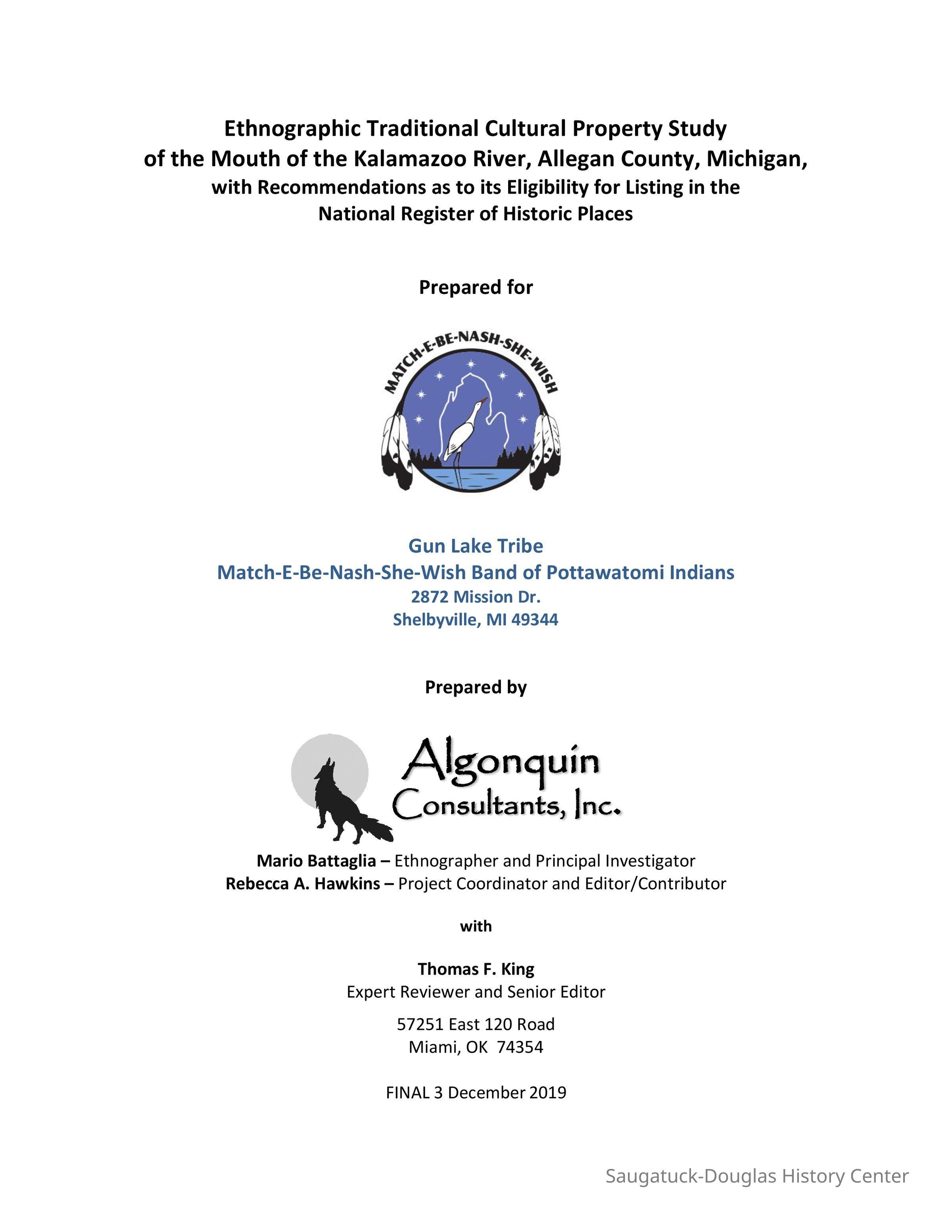Ethnographic Tribal Cultural Property Study of the Mouth of the Kalamazoo River

2025.03.03
Ethnographic Report completed by the Gun Lake Tribe that argues that a large area of Saugatuck/Douglas should be eligible for inclusion on the U.S. Registrar of Historic Places as Traditional Cultural Property. The report was commissioned and filed in the ongoing Corps of Engineers review of the North Shore permit application. The document was shared with the Blue Star Trail board by Daniel DeFranco, Saugatuck Township Manager, on 20 Nov 2024.
0001 Anishinabek/Ojibwe/Odawa/BodéwadmiDevelopment, landDevelopment, resistance to
Winthers, Sally
2025.03
Found
2019
Digital data in CatalogIt
North Shores of Saugatuck, LLCNorth Denison propertyGun Lake Tribe/Match-E-Be-Nash-She-Wish Band of Pottawatomi IndiansFriends of the Blue Star Trail
Table of Contents 1.0 Project Introduction 2.0 The National Historic Preservation Act, Section 106, and Traditional Cultural Properties 3.0 The Mouth of the Kalamazoo River - Traditional Cultural Property Evaluation 3.1 Landscape and Riverscape Approach 3.2 Example Landscape/Riverscape Approach Projects 3.3 The TCP Identification and Documentation Process 3.4 Contributing Elements of the Mouth of the Kalamazoo River 3.5 Non-contributing Elements 3.6 Suggested Property Boundary 3.7 Assessment of the Traditional Cultural Significance of the Mouth of the Kalamazoo River 4.0 Establishing Eligibility for Listing in the National Register of Historic Places 5.0 Connections to the National Environmental Policy Act 6.0 Discussion of Adverse Effects 6.1 The Area of Potential Effects 6.2 Some Tribally Identified Adverse Effects 6.3 Recommendations 7.0 Works Cited List of Figures Figure 1: Location of the area designated by the Match-E-Be-Nash-She-Wish Band as the mouth of the Kalamazoo (red dashed line) and the proposed North Shores marina permit area and laydown area (black polygons). Figure 2: Location of the proposed North Shores marina permit area and laydown area (blue polygons) in Section 4. Figure 3: Historical distribution of wild rice gathering areas in southern Michigan, drafted from an overlay of Barton’s Map 1 (2018:28) on a Geology.com map of Michigan rivers. Figure 4: Artist’s rendition of the mouth of the Kalamazoo River. Figure 5: General Land Office plat maps of part of mouth of Kalamazoo River, showing the broad channel as far as the confluence with the Rabbit River, the mouth’s eastern boundary. Figure 6: Generalized boundary of the mouth of the Kalamazoo TCP (red dashed outline). . Figure 7: The Kalamazoo River is labeled “Kikalemazo” on this 1822 map from the Geographical, Historical and Statistical State Map of Michigan Territory. . Figure 8: Image of Chief Leopold Pokagon, Pottawatomi historical figure associated with the mouth of the Kalamazoo River (taken from Buechner 1933:295). Figure 9: Map of village site (yellow triangle) at the mouth of the Kalamazoo River and burial (yellow circle enclosing cross) to the south side, slightly east of the village Figure 10: An Ottawa-Pottawatomi village (blue triangle) is shown where the Kalamazoo River joins Lake Michigan. Figure 11: An Ottawa-Pottawatomi village (blue triangle) and a trading post (boxed “T”) are shown where the Kalamazoo River joins Lake Michigan.
01/16/2025
01/16/2025
